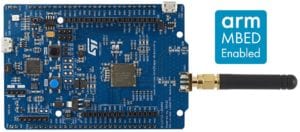X-CUBE-SFOX, launching today, is the first STM32Cube expansion package offering a SigfoxTM stack compatible with the Murata CMWX1ZZABZ-xxx modules. If IoT is obviously invading our cities, some countries are more enthusiastic than others. Case in point, the Taiwanese government recently began to boost research and development into IoT as well as increase adoption by factories and cities, according to a report by Taiwan Business TOPICS. This latest initiative resulted in the release of sub-gigahertz radio spectrums by their regulatory body, and the deployment of the country’s first Sigfox IoT network. Similarly, a €300 million agreement was recently signed to deploy the protocol in China’s 20 biggest cities.
ARVE error: Mode: lazyload not available (ARVE Pro not active?), switching to normal mode
Sigfox is a Low-Power Wide Area Network (LPWAN) that shares some similarities with GSM networks but uses unlicensed bands (ISM) as well as small 12-byte messages and up to 140 messages per day per device. As a result, the data transfer consumes very little power, ensuring small objects can last a long time in the field without any maintenance or battery replacement.
Very simply, a device sends data to the base station, which communicates it to the Sigfox cloud, which in turn will push it to the user’s cloud. From there, developers can call the information using a dedicated API and parse it in an application. An advantage of Sigfox is that its base station is only about the size of a backpack, and it can receive about a million messages a day. Furthermore, because of its range, it’s possible to cover a country like France with a little more than 1,000 base stations only, making the network both practical and affordable.
Why X-CUBE-SFOX Matters?

By offering X-CUBE-SFOX, we simplify development since any design team, regardless of its size, can start writing their Sigfox application using this software package and the B-L072Z-LRWAN1 Discovery kit. Indeed, the development board relies on the CMWX1ZZABZ–091 Murata module, which combines an STM32L072CZ and an SX1276 transceiver. The Discovery kit is highly popular because it’s inexpensive, at a suggested price of US$45, and its Arduino connector means it’s possible to connect a sensor board, turning the entire stack into a quick and efficient prototype. The only thing engineers have to do to make the B-L072Z-LRWAN1 Discovery kit compatible with the X-CUBE-SFOX is to close the bridges SB 13 and SB 26 by applying a little bit of solder on the PCB.
One feature of the X-CUBE-SFOX that isn’t necessarily obvious, but is of tremendous importance, is the code’s portability to one of the many STM32 microcontrollers (MCU), which hastens development and facilitates certifications since the underlying foundation is similar. If a client requires an STM32L1 instead of a typical STM32L0, for instance, it’s possible to port the software instead of starting from scratch. Furthermore, the code in the expansion pack uses a small memory footprint so customers can store the wireless stack and application in the internal memory, thus simplifying the bill of materials and reducing costs. ST’s source code also includes effective optimizations, such as the way it uses the MCU’s DMA (Direct Access Memory) to require fewer CPU resources. Ultimately, all this converges to create one of the best performing platforms in the industry.
Get Both LoRaTM and SigfoxTM
The other significant advantage of using the ST ecosystem is that thanks to X-CUBE-SFOX, the B-L072Z-LRWAN1 Discovery kit becomes today the only development board on the market to be simultaneously compatible with a LoRa and a Sigfox stack. LoRa, short for LoRaWAN (Long Range Wireless Area Network), is another type of LPWAN that adopts a similar philosophy, meaning short messages, long range, and low power consumption to ensure IoT devices can last a long time in the field.
Today, the B-L072Z-LRWAN1 Discovery kit is compatible with both I-CUBE-LRWAN and X-CUBE-SFOX software packs, thus allowing an application to switch from one to the other. For instance, a smart factory could use Sigfox to send environmental information then switch to LoRa on the fly, thus helping engineers determine in real time and in the field the solution that works best for them. It’s also possible that a concurrent mode could allow both LoRa and Sigfox stacks to run alongside one another. For example, a smart building could use both for backup purposes, and if one fails, the other could take over. Hence, the publication of the X-CUBE-SFOX paves the way for new types of scenarios that simply weren’t possible before.
What Can You Do With X-CUBE-SFOX?

With so many features, it’s hard to know where to begin, but a great place to start is the folder containing the example applications that come with X-CUBE-SFOX. For instance, one of them uses an external host, such as an MCU or an external computing system, to control a Sigfox AT modem. By default, the modem is in Stop mode, which consumes only 1.1 µA, and it is waiting for a command to wake it up.
Another example application in the Expansion Pack ensures that when the user pushes a button, the software captures data from the environmental sensors through an I2C interface and sends it to the Sigfox network. The X-CUBE-SFOX also includes the ability to quickly test a Sigfox device in a lab by automatically compiling and loading default credentials, which ends up saving a lot of time and resources.
“The World Is Yours”
Finally, the pack dramatically simplifies the certification process since the software is already compliant with RCZ1, RCZ2, and RCZ4 regions. RCZ1 covers Europe, Oman, South Africa, Iran, and Kenya, RCZ2 is responsible for the US, Canada, Mexico, and Brazil, while RCZ4 is for Colombia, Peru, New Zealand, Australia, Taiwan, and Singapore.
Hence, by using our Sigfox expansion pack, any team can immediately work toward expanding their device’s reach. Furthermore, as Sigfox expands its coverage, ST will continue to add support for new regions, ensuring developers are kept abreast of the latest development and can reach more markets faster. Additionally, engineers will even be able to adjust the transmit power of the antenna to tailor it to the distance of their base station, thus optimizing the power consumption to improve battery life.
What type of application do you think will make Sigfox ubiquitous? Let us in the comments section below.




